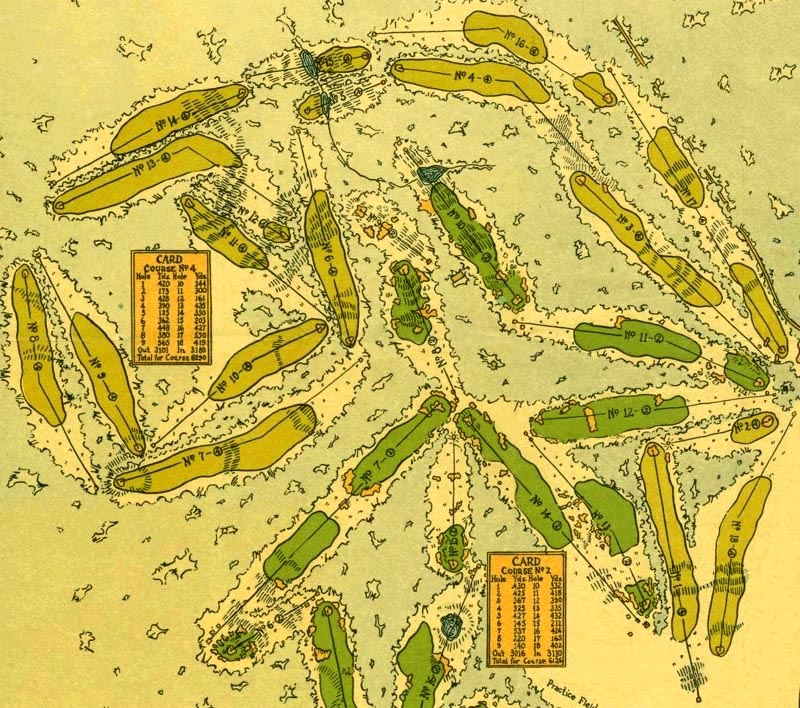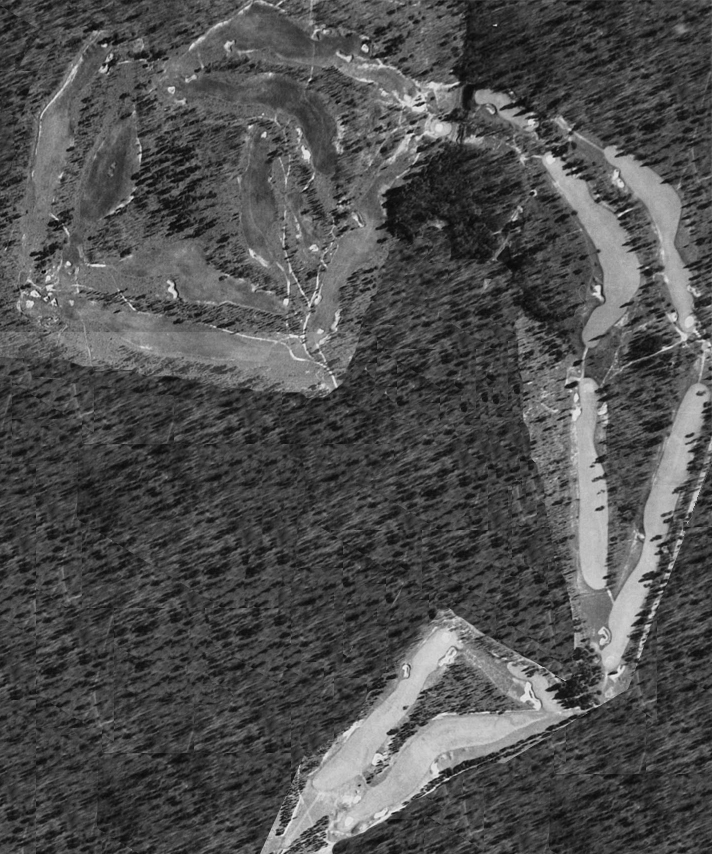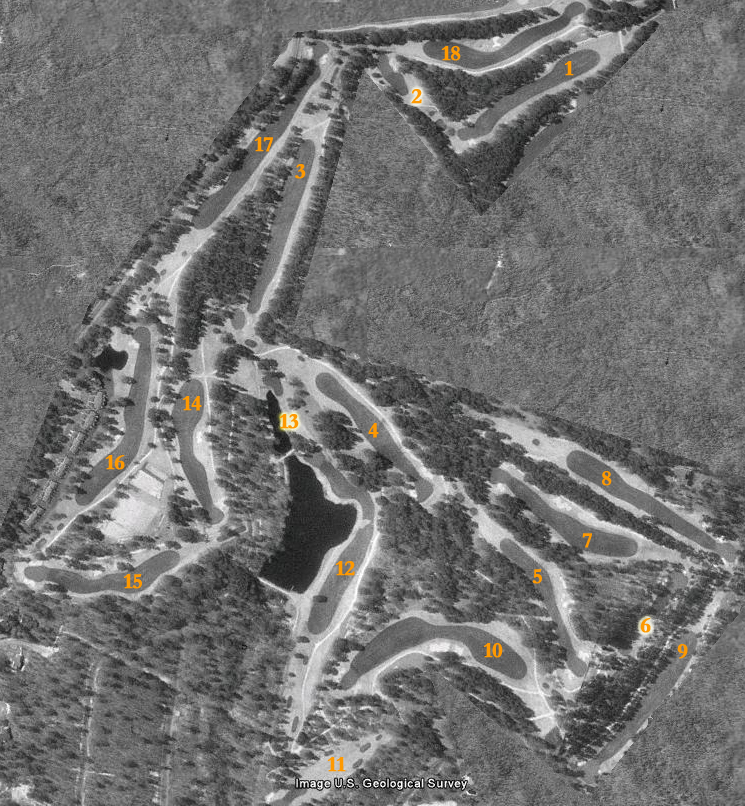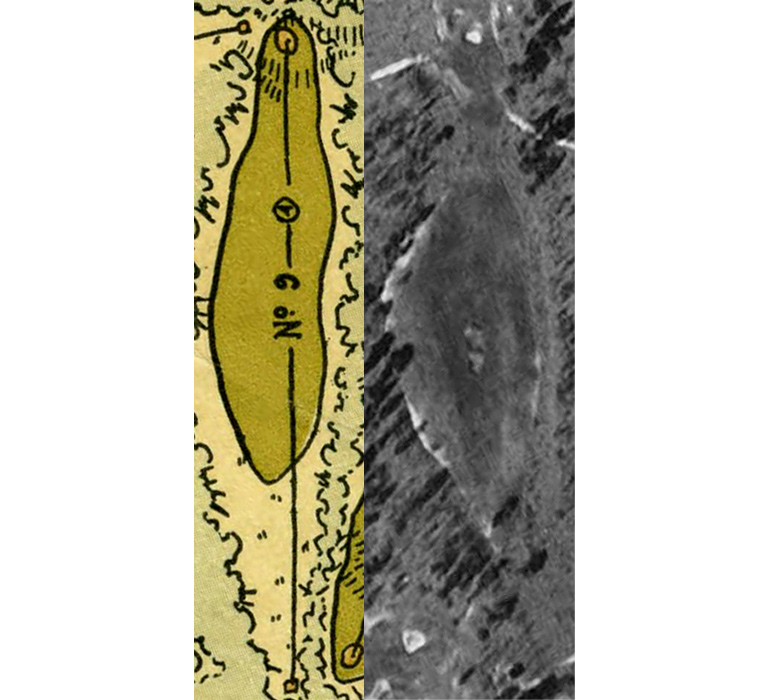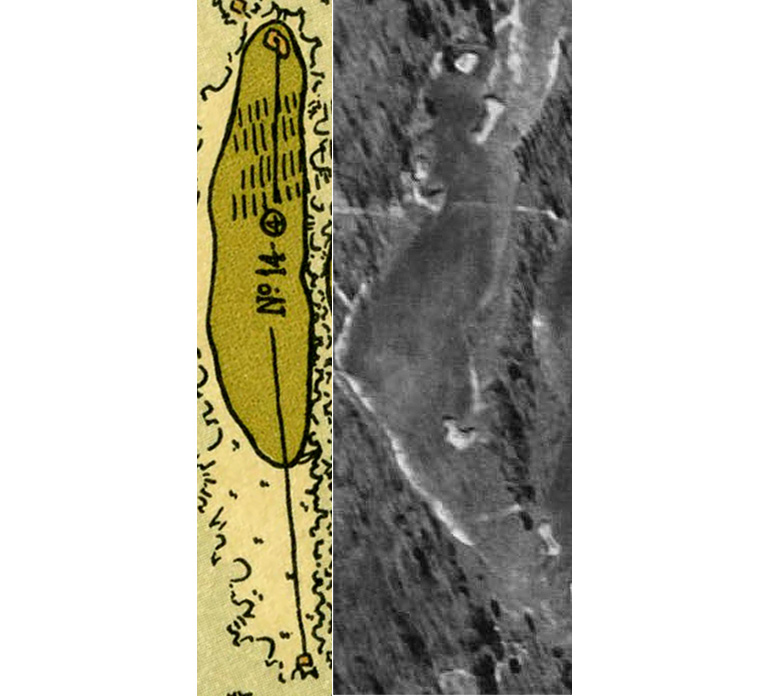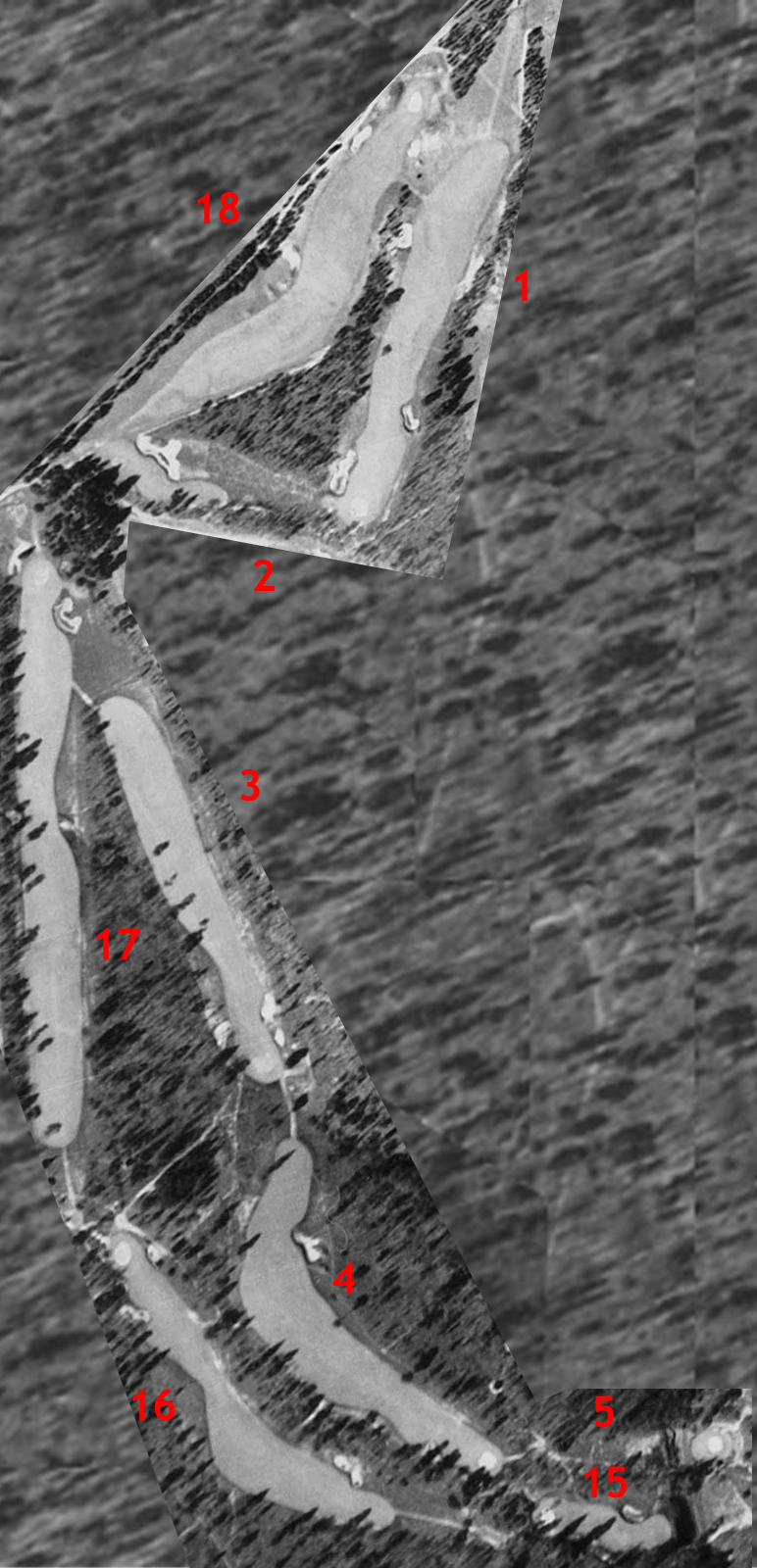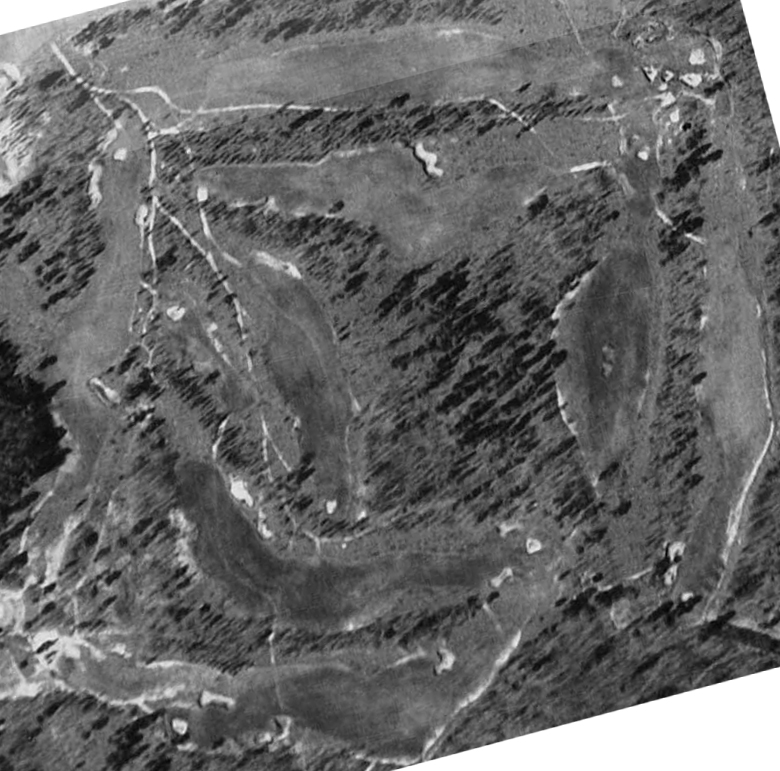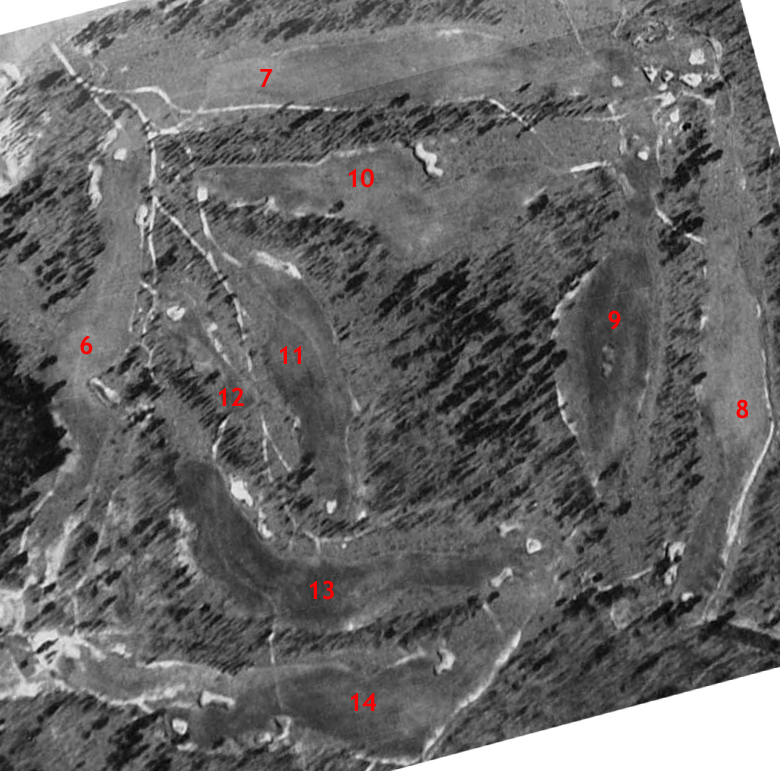A History of Pinehurst No. 4
Chris Buie
January 2011
Just as No. 3 Course was being finished in 1910, it became apparent that 54 holes was not sufficient. Such was the allure of the playing fields Ross conjured up out of the desolate pine barrens. And so, work immediately began on yet another course. Apparently, they didn’t have a great deal of trouble coming up with a name for it.
By 1913 the first 6 holes became open for play – a few years later it was a 9 hole layout. The full 18 opened in 1919 to very good reviews – especially the conditioning – which was said to be the best of the lot.
The following map and the aerial beneath are rather interesting because from them you can, to an extent, deduce how Ross went about fashioning his epic golfing dreamscape. The highly accurate hand drawn map was made in 1922 – just a few years after the course was first created. Unlike modern designs, No.4 had the luxury taking shape over an extended period of years. When a course receives a long form, visceral involvement from an enormously talented designer it tends to bring about a level of architectural quality that does not diminish with age.
Ross lived in extremely close proximity to No.4 for over 25 years.
In comparing the two maps, you can see that Ross made many modifications as he went along. It appears that the demand for more courses was such that he constructed No.4 so it could provide another avenue for play right away, but with the intention of refining it to the highest level of quality as time, experience and reflection permitted. As we will see later, several of the holes were greatly modified and became invested with increasingly higher levels of intrigue. One of the more interesting aspects that stands out is that there were only three tiny bunkers in the earliest version.
The course received a great deal of play until catastrophic effects of the Depression forced the resort to close nine of the holes. The rest of the course was shuttered not long after. (The area around No.4 is photoshopped out so you can focus on the course – but the contrast between the two 9 hole sections is accurate.)
Well, it wasn’t entirely shut down. Before it was used as a pasture for a prize herd of cows, No.4 spent a few of the lean years as an archery golf course. They had targets set up at appropriate distances along the holes and a whole quasi-golf scoring system with it. Archery was a popular outdoor feature for many resorts at the time. It was all about being out of doors. Like many other resorts, Pinehurst featured equestrian sports (including a massive polo field that is still used for such to this day), a gun club (run for a time by Annie Oakley), tennis, lawn bowling – pretty much any outdoor game you care to name. Outdoors – healthy, restorative, fun – in the mild climate.
As the economic winds turned in a more favorable direction so did fortunes of the Resort. The post-war era once again found visitors flocking to the area. Thus, it was decided to refurbish the course. A significant amount of redesign and reconfiguration ended up taking place during this process. The 1950 redesign of No.4 was part of a broader transformation of the resort – at the behest of Richard Tufts.
This broader transformation is a long story in its own right. But in a nutshell here, what happened is that through decades of labor and artistry Ross rendered four luminous courses of ornately detailed craftsmanship – a golfing dream world – out of nothing. Tufts took this legacy and cavalierly turned Ross’s work sideways. It is quite evident that Tufts did not fully appreciate the finely wrought overall masterpiece Ross bequeathed to the golfing world.
The redesign was provided by your GCA hero Robert Trent Jones and it was back open just as the 1951 Ryder Cup was being played on the adjacent course. What RTJ essentially did was to smooth out the course. It would be an smoother go for “average tourist” and taciturn member. The rough areas off the fairways, the dramatically flashed bunkers, the distinctive wave like ridges of the greens – all watered down. And that did work in regard to appealing to the tourists and members. Those folks did not have an appreciation of “distinctive elements” and adventuresome greens. I think you can say this is reflective of a shift in the predominant tastes of the American culture in that era. Reflective of the questionable tastes that reached their peak in the 1970’s with things like wall-to-wall shag carpet, double knit sans-a-belt slacks and muzak. Think that is a stretch? Perhaps, but courses are reflective of the broader cultural trends, are they not?
Robert Trent Jones version:
Although some modifications occurred, No.4 continued on with the monotonous RTJ version until it was decided in the 1990’s that it needed to be spruced up and show qualities which would stimulate new interest. This time they wheeled in Tom Fazio to provide such. Something more visually striking and a perceived update of the Ross ethos, that is. With his huge amount of small sand bunkers Fazio did provide a visual element which appealed to the majority of visitors. The severe crowning of the greens and the many long sandy ‘waste areas’ were supposed to be an homage to Ross – specifically No.2 course. Although, neither the greens or the waste areas are that close in spirit or playability to what Ross wrought, it did stimulate interest and increase play. This is the version we have today.
Mr. Fazio (again, the adjacent area is photoshopped out):
To get a sense of how the course was modified over time from Ross original vision lets look at a representative hole: the original 10th.
RTJ had it as his 7th hole and later Fazio made it his 8th. The images speak for themselves. With Ross we have a rough hewn native area off the tee that leads to a strong, strategic bunker. You can tell by the shadow that it was deep – and that you almost certainly were not going to par the hole from there. He gave you a very wide area left of the bunker as an option. He could have had trees much closer in – or a narrower fairway. He thought it played best this way. For the optimal angle you had to challenge a very difficult bunker – but the player was given another option with the caveat that they would have to work a little harder since they took the easy way off the tee left.
Moving on, you can see RTJ’s version in the middle. The natural area off the tee – gone. The bunker neutered. The fairway tightened. The fairway green. Nothing distinctive about the hole. No personality. It doesn’t appear to be that different from most of the other holes on the course. No character. Indistinct. Bland.
As with most of the other holes Mr. Fazio has put in a cluster of bunkers where the original was. Where the natural area was is very white sand. Although you can’t see it from the aerial, the green is super crowned with seriously deep roll off areas. That is very characteristic of how the vast majority of greens play on his version. It is very challenging – much more challenging than courses No.1, No.3 and No.5. In fact Fazio’s version is seriously challenging all around. They used it for qualifying for the 2008 U.S. Amateur. They grew the rough very high then and you had to hit an extraordinary shot to keep it on the greens at that time from that rough.
Now lets have a look at some interesting holes that went by the wayside – but could be reinstated. Interestingly, these holes all featured tremendous width off the tee. RTJ was known for narrowing fairways. That is perhaps the most stark contrast between the two architects. In my opinion, wide fairways are much more preferable than narrow alleys. Did you know that the average PGA touring pro misses four out of ten fairways? These pros are the most talented players, who practice endlessly and constantly receive instruction. Yet, they still miss four out of ten fairways. How does that bode for the vast majority of players? The game is a lot more enjoyable and strategic with wide fairways. Ross was unequivocal in his belief that the playing of his courses was intended to “be a pleasure, not a penance”. And he was on the first wave of the strategic architects. I am guessing that these are among the main reasons why he favored wide fairways – and in No.4’s case, extremely wide fairways. I do not know why RTJ preferred narrow fairways on non-tour courses. Presumably he wanted to test the golfer. He probably was one of the leaders of the architectural movement which brought about the building of the demanding “championship” courses which were the predominant style for the next several decades. The accent was on challenge rather than fun and strategy.
The 365 yard 9th hole seems to be a unique hole for Ross. There appears to be some sort of vertical, double hazard in the middle of the fairway. I am not aware of any other Ross holes which employed this. You can strategically approach the hole in any any number of ways – short, over, left or right. He did want you to think and have options – and #4 was conceived in the era when the architects were first attempting to deliberately provide the golfer with intriguing, thoughtful journeys rather than just rambling around in fields. The hole is rare with the severe bottlenecking which occurs short of the green. Rough native areas provide something for the ground game player of the day to consider. A very interesting hole – far more interesting than RTJ or Fazio.
The longish 435 yard 13th became a sharper angled dogleg through the years. I like the early version better than the sharply turned dogleg.
You can see the 350 yard 14th was greatly modified through the years. The theme of a serious bunker with a very wide driving area continues here. Perhaps Ross had this in mind all along.
The 362 yard 6th is another wide fairway with a strong bunker on the right off the tee. Ross could have varied the strong right bunker design element a bit more. It was, perhaps, a bit overused on this course.
Although they are literally side-by-side, the terrain of No.4 is more varied and interesting than No.2. You can’t tell that from aerials but the following postcard of the 11th give you some perspective. Another very wide fairway, as well.
Epilogue
It is difficult to give an accurate assessment on just how good Ross’s final version of this course was. Here is what is attributed to the man himself in the 1919 Pinehurst Outlook:
“Mr. Ross is warm in his praise of No. 4 course which is now a complete eighteen hole affair and states that he considers it will be the best golfing proposition of all when it has been fully trapped and the fairgreens developed.” – Pinehurst Outlook
One thing about Ross is that he was effusive in his praise for virtually any course he had just designed. As he was a man of integrity, that is most likely how he genuinely felt at the time. However, while having some value, his initial comments may not be the best way to measure the merits of his designs.
Without a doubt, there were several great holes on No. 4. Assessing the quality of some other holes which are no longer with us is an elusive proposition. Even one keenly familiar with the terrain would have to play them as they were to provide an accurate appraisal.
Nevertheless, it is almost impossible to picture Ross turning out something less than extremely good on his home terrain in Pinehurst. After all, his knowledge and skill had grown exponentially by the time he started in on No. 4.
Couple that with the fact that this perfectionist lived in very close proximity to the course for decades and one can be safe in stating that it did provide a highly compelling journey.
The course, as it is, has many fans. After No. 2, it is the most challenging layout attached to the clubhouse. Although the state‟s rankings of the courses are not even close to being accurate (Myers Park ranked higher than Old Town???) it is worth noting that No. 4 is highly ranked. And as was stated before, it was even used for qualifying during the 2008 U.S. Amateur.
With these facts to be considered it would not be such an easy matter for the club to just up and say “return it to Ross‘s day”.
However, this club and this course are going to be around for as long as the game of golf is going to be around. At some indeterminate point in the future – perhaps a few decades away, perhaps a bit sooner – consideration for modifying the present course will make its way to the top of the list. When that day comes, it would be advisable to give consideration to the craftsmanship Ross worked into this quadrant of this landscape.
“It is the intention of Mr. Tufts that Pinehurst shall forever hold the palm among the world’s golf resorts. To this end Mr. Ross devotes his genius.” – Pinehurst Outlook
THE END
Well, not quite the end. Lets have an epilogue. You are knowledgeable regarding such matters. Why don’t you have a look at the hight resolution photos of the original course below – and draw your own conclusions.
Again I photoshopped out adjacent holes so the focus is on the merits of No.4.
The course begins with a vertical descent to take you out past the preexisting No.2 Course.
Once past No.2 Course – and directly below the current 10th hole of No.2 is the core area of the course – annotated beneath.
The following aerial has the first hole at the top, followed by the one shot second. That would be the closing hole at the bottom.
Chris Buie is the author of The Early Days of Pinehurst


